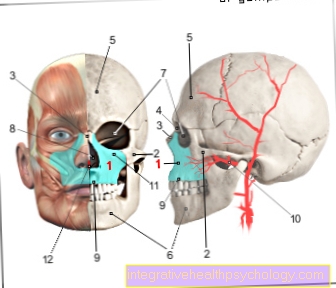Retinoblastoma
Synonyms
Retinal tumor
What is retinoblastoma?
A retinoblastoma is a tumor of the retina (on the back of the eye). This tumor is genetic, that is, hereditary. It usually occurs in childhood and is malignant.

How common is retinoblastoma?
Retinoblastoma is a congenital tumor or it develops in early childhood. It is the most common eye tumor in childhood. In about a third of the cases, both eyes are affected. More than one tumor can develop in one eye. The tumor usually develops before the age of 3.
Detecting a retinoblastoma
What are the symptoms of retinoblastoma?
The affected children are often symptom-free, i.e. they do not express any pain. Occasionally, children with retinoblastoma may squint. This is why the fundus of the eye is always examined as part of the initial examination of cross-eyed children (see fundus examination) in order to exclude such a tumor. Inflammation of the eye that persists for a long time can also be an indication of a retinal tumor.
The typical distinguishing feature of retinoblastoma, however, is of a completely different nature: the parents come to the doctor with the child because they noticed a difference in the pupils in photos of the child. The children have a normal, red pupil and a different-looking pupil that lights up whitish. The medical term for this is leukocoria (Greek. leukos = white, kore = pupil).
At this stage, the retinoblastoma tumor has progressed so far that it already fills a large part of the vitreous space, which extends from the lens to the posterior pole of the eye. One also speaks of a cat's eye.
How is retinoblastoma diagnosed?
The diagnosis of retinoblastoma is made by the ophthalmologist using an ocular fundus. A light source and a magnifying glass are used to look through the pupil and lens into the back of the eye. The vitreous cavity and retina are preferably examined here. The tumor can be recognized very well and easily by its bulbous, whitish structure. If the tumor becomes too large, it breaks into the vitreous humor. Parts of the tumor can float in the vitreous space.
Ultrasound, X-rays or a CT scan of the eye can also be performed. Here you can typically see foci of calcification. However, these methods are more likely to be used in the case of doubtful diagnoses and are not part of the routine. Computed tomography can also exclude scatter along the optic nerve.
Read more on the topic: Examination of the fundus
Treating retinoblastoma
How is retinoblastoma treated?
As already explained above, the retinoblastoma tumor is already well advanced at the time of diagnosis and is therefore relatively large. In these cases the eye must be removed. During this so-called enucleation, the largest possible stretch (1 cm) of the optic nerve must also be removed in order to avoid a possible spread of tumor cells.
Chemotherapy can also be used for smaller tumors. In this case, the tumor usually shrinks somewhat and a radiation body can be sewn on. This belongs to the large group of radiotherapy procedures.
Tumors that are still small at diagnosis can be treated with such a radiation body from the start. If these retinoblastoma tumors are located quite far outside on the retina, then cold therapy (cryotherapy) can be used.
Preventing retinoblastoma
How can retinoblastoma be prevented?
Since retinoblastoma is hereditary, it cannot be prevented. However, regular follow-up examinations help detect a possible recurrence of retinoblastoma at an early stage. These follow-up checks must be carried out for 5 years. The second eye must also be thoroughly examined. To ensure this, the children should be put under a brief anesthetic. The pupils are dilated with special eye drops.
In the first two years the controls are carried out every three months, then every six months or annually.
Can retinoblastoma be inherited?
What is the retinoblastoma gene?
Retinoblastoma mainly affects children. This is because it is a hereditary disease that is passed on from parents to child. If the child has the affected genes, the retinoblastoma often develops within the first 3 years of life. It is the most common eye tumor in childhood, which is why it has been very well researched.
Researchers have discovered that the gene for a retinoblastoma is located on chromosome 13, more precisely on the locus chromosome 13q14. This chromosome contains all information for the tumor suppressor retinoblastoma protein Rb. A tumor suppressor is a protein that controls the growth of a cell. If the DNA is damaged or mutated (changes), they can send the cell into self-destruction, thus preventing further damage.
In retinoblastoma, however, this tumor suppressor Rb is changed by a mutation and has lost its physiological function. This lacks this natural defense function and further mutations are not destroyed, so that the cell can continue to grow in an uncontrolled manner. This creates a tumor.
How is retinoblastoma inherited?
There are two different types of retinoblastoma. On the one hand there is the sporadic (occasionally occurring) retinoblastoma, which occurs in 40% of cases. This leads to different changes (mutations) in the affected gene and ultimately to the development of a retinoblastoma. This usually only occurs on one side and it is not passed on.
Inherited retinoblastoma is referred to as the hereditary (hereditary) form, which occurs in 60% of cases. The gene is passed on from the mother or father to the child. Both parents do not necessarily have to be affected and can only be carriers of the gene. In this form, however, retinoblastomas usually develop on both sides. In addition, the risk of other malignant tumors, for example the bones (osteosarcomas) and connective tissue (soft tissue sarcomas), is increased.
Course of a retinoblastoma
How good are the chances of recovery from retinoblastoma?
In well-developed countries and with early diagnosis, the chances of recovery are very good. The therapy includes different approaches from chemotherapy, laser or surgical therapy, depending on the stage of the tumor, and is carried out in specialized centers. If the retinoblastoma is diagnosed early, a treatment concept can be drawn up and initiated in a short time. The mortality is then only below 5%.
With untreated or undetected retinoblastomas, the mortality is much higher because the tumor can spread to different areas of the body over time. Patients with hereditary, i.e. inherited, retinoblastoma also have a poorer prognosis, as they have a higher risk of further malignant tumors.
What is the prognosis for retinoblastoma?
Thanks to the most modern therapy options, the death rate from retinoblastomas, even if they occur in both eyes, is only around 7%. However, if the optic nerve is also affected, this number increases.
Even in healed patients, further tumors occur in 20% of cases, be it on the other eye or on other parts of the body, such as the bones. This is why these patients should be carefully monitored in order to detect secondary diseases at an early stage. In addition, the patients should be X-rayed and thus exposed to radiation as little as possible.





























